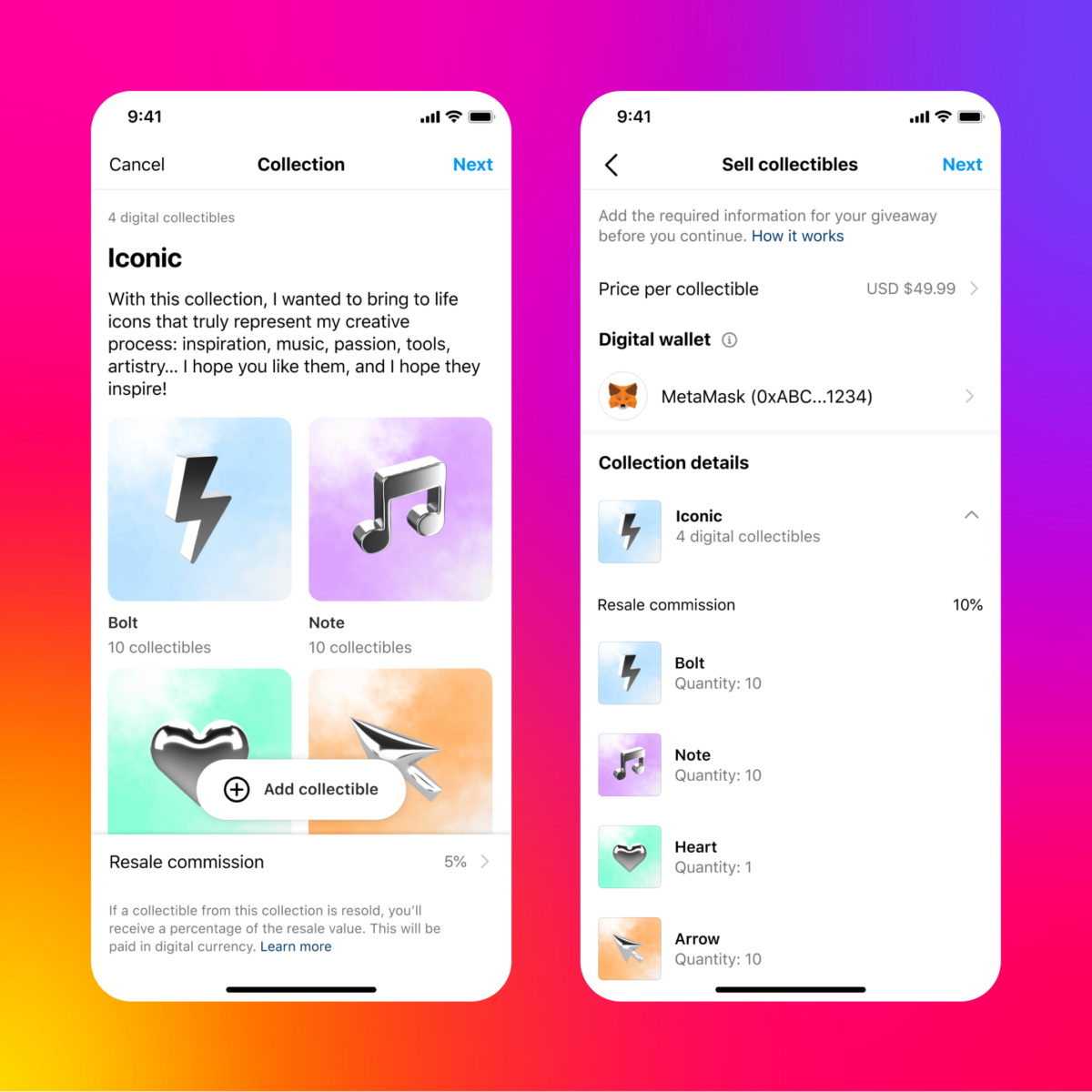Instagram is officially an NFT marketplace
The Alpha:
- Meta has begun rolling out features that allow creators to sell NFTs on Instagram, according to information shared with nft now.
- To start this process, Instagram has made new features available to a select group of creators on its platform. More creators will be joining in the next few weeks.
- The first round of selected creators includes Amber Vittoria, Dave Krugman, Refik Anadol, Isaac ‘Drift’ Wright, Eric Rubens, Jason Seife, Vinnie Hager, Sara Baumann and Ilse Valfre.
- Meta spokesperson Christine Pai told nft now that when digital collectibles are purchased on Instagram, neither the creator nor the collector has to pay any gas fees. However, she stated that this would be true “at launch”, indicating that this may eventually change.
Since Facebook changed its corporate name to Meta in late 2021, much of the tech giant’s efforts have been centered on expanding its reach into the growing Web3 landscape. An important initiative Meta took during 2022 was to integrate NFTs into its social platforms, Facebook and Instagram. As early as January this year, there was buzz that Meta wanted to allow users to create, display and (of course) sell NFTs on its market-leading platforms.
But before Meta officially launched its NFT effort, it had to address a significant issue related to NFT-related content that violated its terms of service.
In particular, Meta started the year by banning the fake @NFT Instagram account supported by Mark Cuban. The account flooded its nearly 2 million followers with posts about dubious NFT projects. Ultimately, @NFT was banned for posting sponsored content about NFT projects without disclosing that the posts were paid for, a violation of Instagram’s Terms of Service and FCC guidelines.
Several months later, in March 2022, Mark Zuckerberg announced his intention to turn Instagram into an NFT marketplace; However, he did not reveal any details at the time. Finally, in a May update to Instagram, Meta began testing its NFT capabilities. Specifically, it gave select users the ability to share NFTs they created or collected on their profiles and in their followers’ feeds. “Similar functionality is coming to Facebook soon, along with augmented reality NFTs on Instagram Stories via Spark AR, allowing you to place digital art in physical spaces,” he said in the official announcement.
In June 2022, Meta unveiled its entire NFT roadmap. And shortly after, in August 2022, the company launched NFT capabilities to users in 100 countries worldwide.
However, the platform’s core NFT functionality was yet to be added. Namely, the ability for users to buy, sell and trade NFTs with each other through Facebook and Instagram. Based on today’s revelation, that will finally change. With this round of public testing, select creators will be able to sell and trade NFTs with the public on Instagram.

An Instagram creator responds
Dave Krugman is one of the creators selected to test Instagram’s NFT marketplace features. In an interview with nft now, Krugman said he is excited about these new tools, as they will allow him and his community to share in the value they create.
“In an age of interconnected creative societies, the name of the game is incentive alignment. If the things that benefit the public also benefit me, we are able to create a social symbiosis,” Krugman said. He went on to explain that NFTs create an economic bond between creator and collector that aligns their priorities. “When someone owns a digital asset that I’ve created, the value of that asset is tied to my own creative success. Thus, our incentives are aligned at a deep level – we share a common goal, and that creates a healthier connection between the community and the creator,” he said.
Krugman also noted that these features could help him better reach specific subsets of his audience. “Digital collectibles allow me to create niche communities within my larger community, micro-economies that help fund and fuel my creative craft. The more support I get, the further I can push my ideas. And the further I push them, the more I get support. It’s a good cycle,” he explained.
Krugman added that it’s only fitting that Instagram would be the first to integrate NFTs into the user experience to this extent, given the role it has already played in removing gatekeepers from publishing. “Instagram was a catalyst in my creative career. It decentralized the publishing of images, much like the printing press did for the written word. It changed everything for me, and this next step is a clear continuation of that decentralization of access and engagement with the public,” said he.
What will be next
In an effort to ensure that this process is as seamless as possible for all involved, Meta has promised that NFTs sold on their platforms will not incur any additional fees for the parties involved. Of course, that doesn’t mean it is no fees. Purchases made in the Instagram app on Android and iOS operating systems are subject to applicable app store fees. And Instagram may add its own fees. However, Pai told nft now that Meta has “committed to not charging any additional fees for the sale of digital collectibles until at least 2024.”
This point may cause some creators to worry. After all, Meta’s previous statements indicate that they intend to take a massive cut of sales on Horizon Worlds, their flagship metaverse product.
With a significant focus on ensuring that NFT integrations on their platforms are available, the fruits of Meta’s NFT-driven initiatives may take some time to blossom. But when they do, we may see one of Web2’s most important platforms grow into one of Web3’s. Krugman, for one, is hopeful. “The NFT community would be wise to understand how intertwined we are with social media, […] I believe with our powers combined; we can create a more sustainable system for creatives working in interconnected online communities,” he said.


